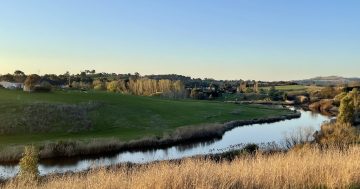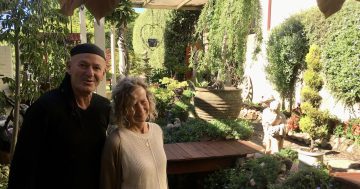Can you have your avocado and smash it too?
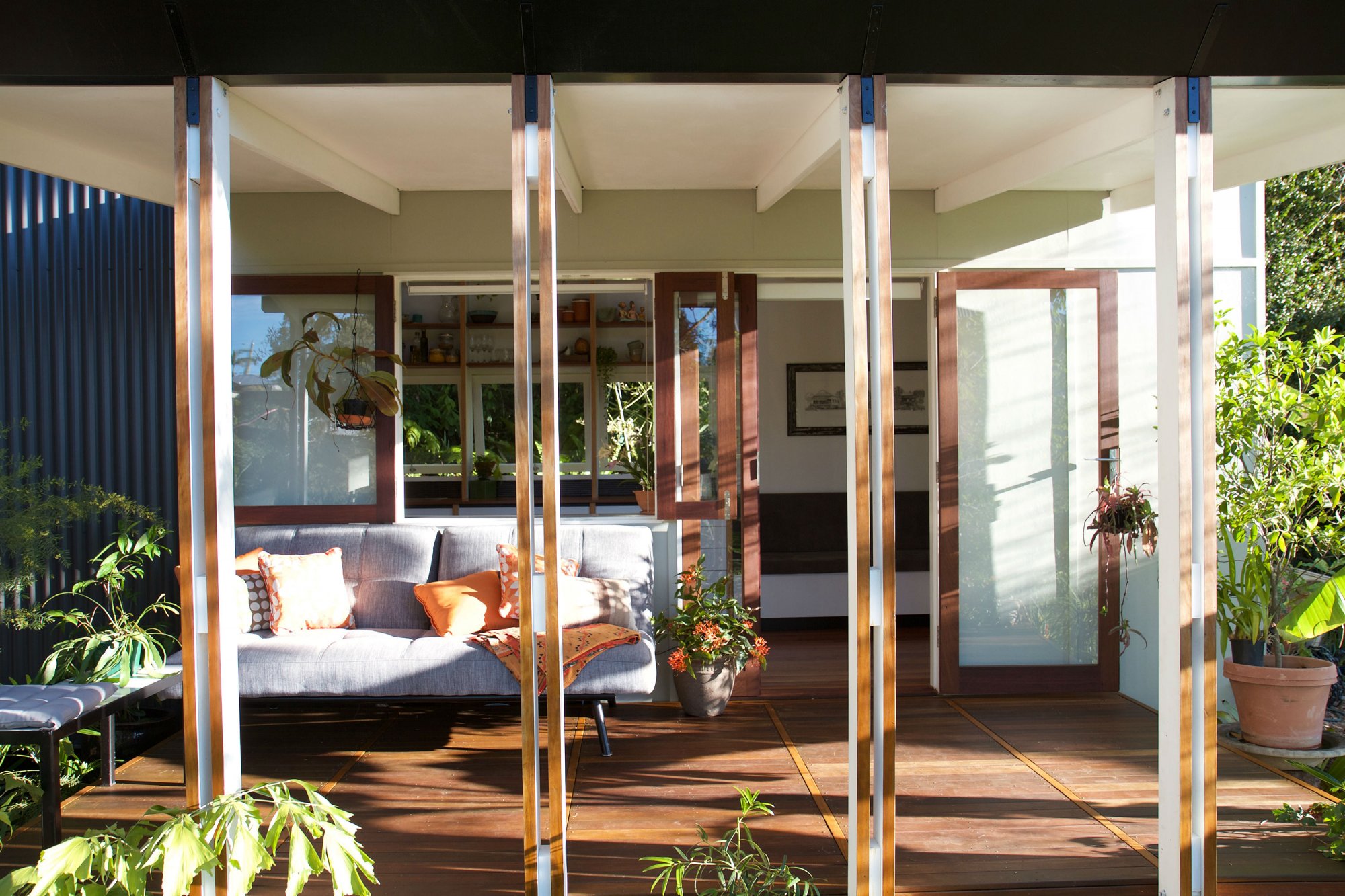
Tiny house with deck. Photo: Tiny House Company
If there is any subject that raises anxiety levels in the community, it is the seemingly unresolvable subject of buying affordable housing and land.
In Part Two of my two-part series, I am peeking beyond some of the commonly predictable options: a large mortgage, an apartment or even both. In response to the poll run with Part One of this article, clearly many would prefer not to live in an apartment. People want space, a garden and privacy. Canberra wasn’t planned with the intention of a lot of high-rise and many regard a house and a block of land as the norm. But with the rapidly escalating price of land in the ACT, and as much as I don’t want take Barnaby Joyce’s throw away line too seriously, there just might be something in what he has had to say recently about moving to regional centres to purchase reasonable priced houses or land.
The cynic in me says Barnaby was just trying to make Tamworth look more palatable. Tamworth is way off most people’s radars, but towns like Cooma, Yass and Goulburn are all within good commuting distance of Canberra and most jobs. If they are not already well on the way to becoming dormitory suburbs of Canberra, it could well happen quite soon.
But before we head off outside the borders of the ACT, I thought it would be useful to round up a few different types of alternative housing available. It would be good to think most of these less expensive building options could work equally well in the ACT, a nearby regional town, or on a small acreage.

8.4 metre yurt on display at Yurtworks, Goulburn. This size has huge potential. Photo: Maryann Mussared
Yurts remain popular as either a stand-alone solution or extra living space that can be added to or relocated later. For many years, it has been possible to add extra space to existing homes with a granny flat. Then there are all manner of really well-designed kit homes, demountables and tiny houses on wheels that are realistic and less expensive alternatives to conventional housing. Some are even converting shipping containers. Given the mixed feelings towards Westside, I can see this alternative as lacking appeal, even though there will probably be lots of cheap shipping containers up for grabs when someone gets around to demounting that eyesore.
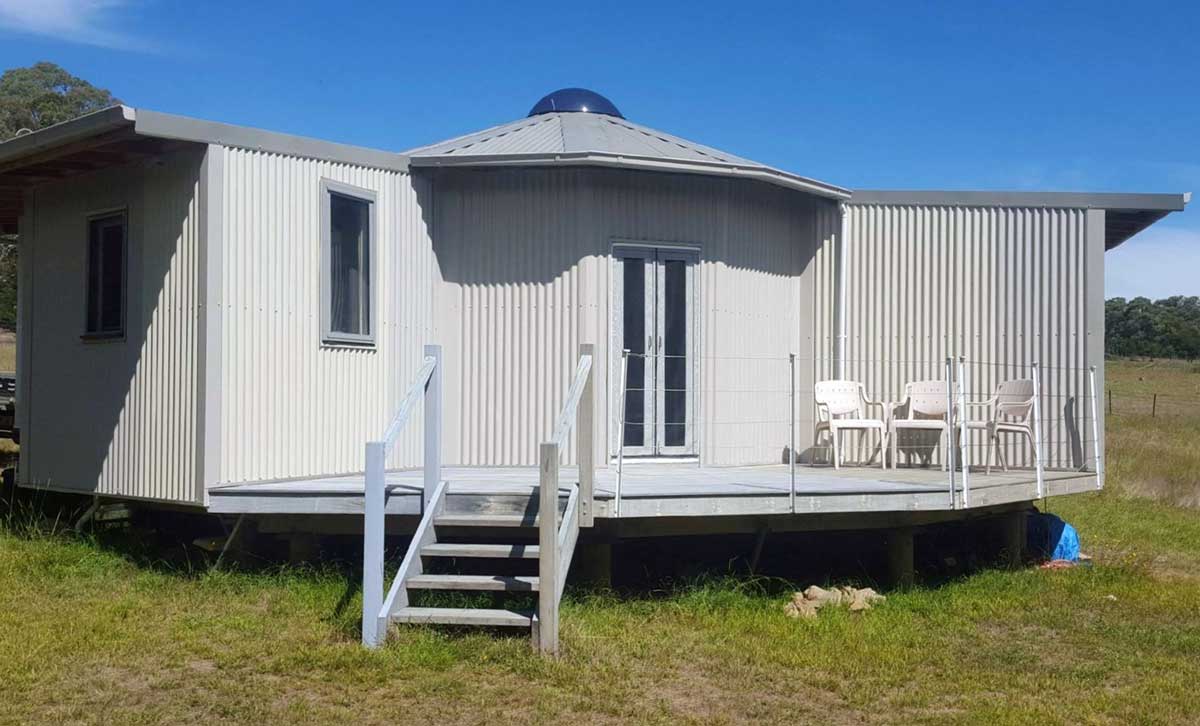
Colorbond clad yurt with added extras, located in regional NSW. Photo: Yurtworks, Goulburn
Back to the yurt. Over the years I have discovered in situ a number as delightful additions to homes in the ACT and as guest accommodation on rural properties. Yurts are an excellent pre-fabricated building unit, and can be used as an office, studio, a simple extension or a weekender. These have always appealed to the ‘old hippy’ in me and I love the concept of the original soft fabric design converted into a solid shape. Goulburn Yurts have a range of sizes that can start as a single unit and be added to. They now have a granny flat line with an instant bathroom unit, which will greatly add to the appeal of the yurt as a flexible housing option. Their website has some great photos and indicative prices.
Another favourites is the tiny house option, commonly referred to as a ‘movement’. It offers the possibility of putting the cart before the horse when you buy your house before you buy your land. It also goes hand in hand with off-the-grid living. Darren Hughes, founder of the Tiny House Movement Facebook Page is enthusiastic about the level of interest being shown. He believes it is not just about the tiny house, but quality of life.
“It is something that attracts people who have made a conscious decision to make sacrifices, reject consumerism and declutter. Do you own your stuff, or does your stuff own you?” he asks.
Buy your tiny house first and live in it: park it in someone’s large back garden, rent some spare land, or sublet a farm, while you save further and decide where you want to eventually live and look for land. If you don’t like where you have set up house, you can just move on. When you make all your decisions you can extend, turn it into a holiday home or resell it.
My attention was particularly drawn to the tiny house movement after I learnt a Brisbane couple had built a tiny house in a back yard and defied all odds by getting it approved by the local Council. Lara Nobel and Andrew Carter run the Tiny House Company and can provide the trailer and custom build for you, or you can buy the trailer and DIY to save costs.
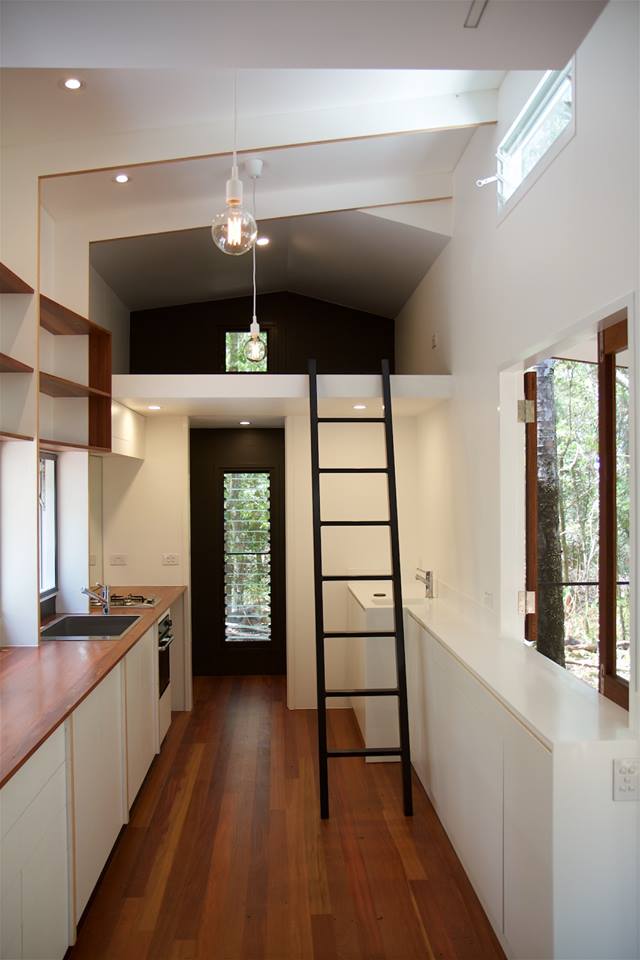
Simple but very liveable space in a tiny house. Photo: Tiny House Company
I marvel at how they have created a perfectly liveable space with everything most people need. They quote about $80,000 for the basic trailer frame and simplified cabinetry. DIY is an option to save money, and solar panels and a composting toilet are extra. The clever and functional design means interiors can be fitted out with anything and everything from Ikea. There are all sorts of creative additions such as the retractable bed that of course is incredibly clever, but again costs extra. Very small houses are not new, but putting them on a trailer and calling them a tiny house is very trendy. People are committing to the whole decluttering and downsizing thing, and intend to live happily ever after. What amazes me about the tiny homes is the internal space is limited, but with a bit of cunning landscaping and the odd covered timber deck, living space expands greatly. They are popping up in regional areas on large blocks of land and now doubling up with existing houses on large suburban blocks.
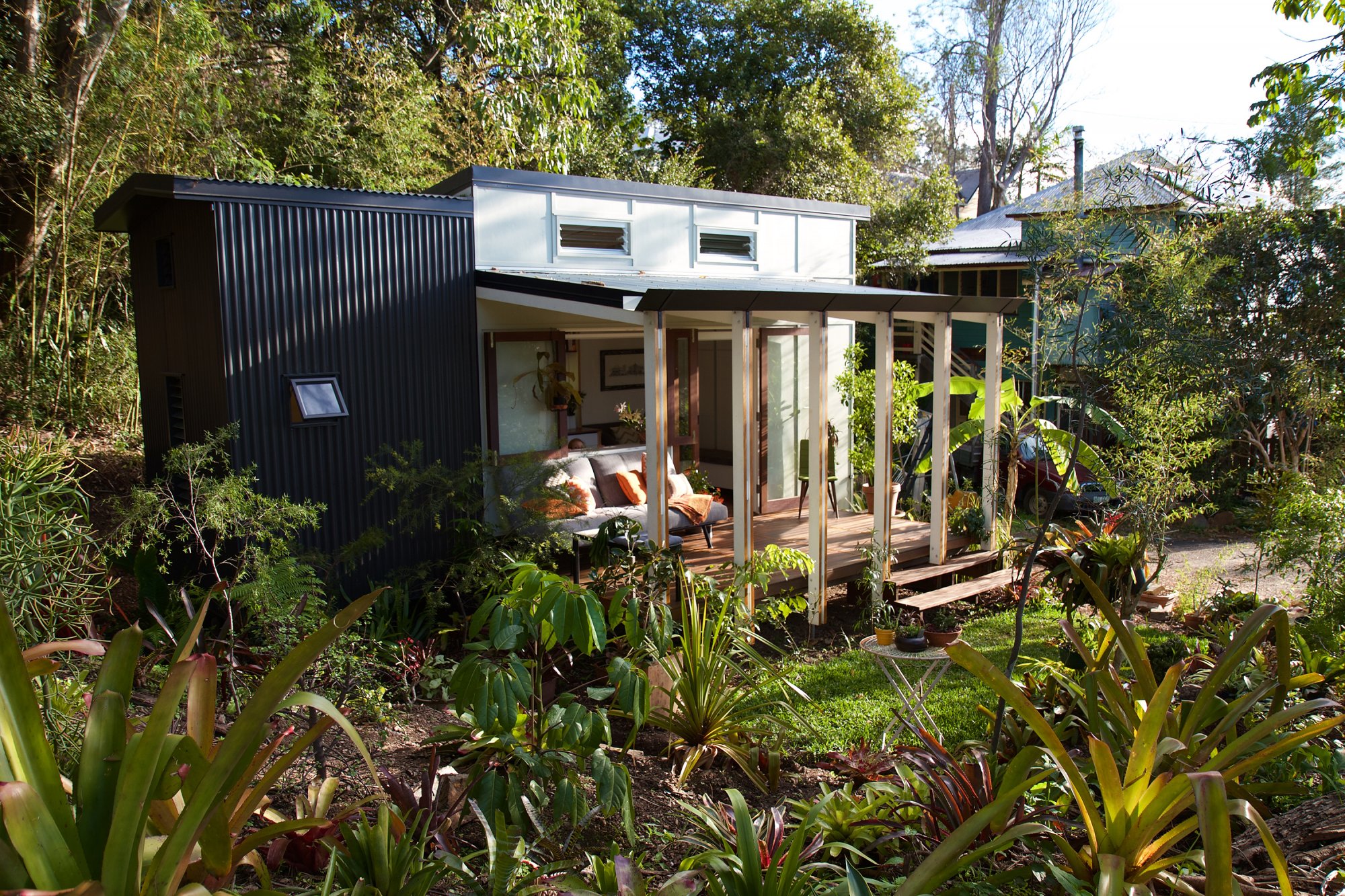
This famous Brisbane tiny house is now legal and set in a lovely tropical garden. Photo: Tiny House Company
The next three off the production line at the Tiny House Company are all destined for Tasmania. This is a different type of housing model: part modular home, part caravan. It is the caravan bit that will interest some. As they are not a fixed structure, you cannot get building approval but knowing the idea of the tiny house already appeals to many, I am interested in whether the idea can be pushed further. Councils have to face the fact demand will increase. I checked with the ACT Environment, Planning and Sustainable Development Directorate and their attitude to caravans is if they are not connected to services, special approval is not required. Of course, consideration must be given to grey and black water management, solar panels and a composting toilet.
Other alternatives are kit homes such as the home Canberra Outdoor Structures presented, fully constructed and furnished at last year’s Outdoor and Leisure Home. The 40 square metre home kit was priced at $40,000 and can be custom built for an extra $10,000.
Then we have that old favourite: the granny flat. Many houses built in the ACT from the 1960s to 1980s had a granny flat. Houses with suitable space underneath sold for a premium as they provided an income, or they may even have housed the odd granny. Goulburn’s Yurtworks have long sold yurts to ACT residents, but have now diversified into adding granny bathrooms. They are well worth a visit next time you pass through Goulburn.
Well, if it is possible to build a small home for a reasonable amount, then doubling up with a block of land that you can afford will double your joy.
People have noted with dismay the high cost of land in the ACT with the equivalent of a quarter acre block now costing over a$1 million, if you can find one. To find cheaper land, we probably do have to have a bit of a look at Barnaby’s recommendation and check out the regions.
There have always been a whole range of arguments for and against moving out of the comfort zone of Canberra suburbia and seeking affordable land and the sort of privacy not readily available in the ACT. Arguments against include commuting time when most people in Canberra have traditionally worked set hours. A second reason has been lack of connectivity. Arguments for include lower land prices and rural blocks that offer space and privacy.
So if you reduce the necessity to commute, and increase connectivity, the attraction of going regional greatly increases.
The best way to reduce commuting time is teleworking, which is increasingly seen as something reasonable for employers to offer workers, rather than a favour. This way of working remotely some of the time is happening and is becoming more common. Millenials increasingly want to work part-time and do not see work as being the defining element of their lives. The Department of Communications even identified this emerging trend of employees, using technology to work from anywhere, as become more important for businesses and government agencies back in 2013.
But if you move out of Canberra and telework, you need good connectivity. It is becoming obvious that the capital of Australia does not seem to be a priority for the roll-out of the NBN. Well guess what? Our nearest regional neighbours are way ahead of us and connectivity is now much less of an issue than it has been in the past.
Here is a roundup of three regional centres:
COOMA has a population of 6,500 with a fairly static population growth. It has a strategic plan in place for the future, and will greatly benefit from the roll-out of the NBN which commenced in October.
Not a lot of people commute to Canberra currently with the last figure available from the 2011 Census of 200 commuters.
The attitude of the local Snowy Mountains Regional Council to tiny houses and alternative housing, including kit homes and yurts, and people wanting to go off-grid on rural blocks, seems positive. They are more than happy to work with people so long as they work within the limits of the Local Environment Plan. Housing in the town is a similar price to other regional centres and I easily found a house on 850 sq metres for $259,000.
YASS, to the ACT’s north, is the centre of a region with over 16,000 residents. The town has a projected population (ABS) for this year of 7,840 and annual growth of 1.8%. The region starts just north of Hall, goes west to Burrinjuck and Wee Jasper, north to Binalong and includes Gundaroo, Sutton, Bookham and Bowning. The region also includes Murrumbateman with a population of over 3,000. 3,500 motor vehicles leave Yass Valley Local Government Area daily for employment in the ACT, as well as over 400 students each school day.
New housing developments such as Fairley are humming along in Murrumbateman and offer the desirable quarter acre block for a third of the cost in the ACT. I wonder if it is too much to hope that the ACT Government and Yass Valley Council will prioritize upgrading at least some of the worst parts of the Barton Highway and start the long-promised duplication as soon as possible. There were also rumours last year that the very fast train consortium Consolidated Lane and Rail Australia (CLARA) was positioning itself by buying land around Yass.
NBN rollout commenced to Yass in late 2016 with no completion date provided and Murrumbateman commenced early 2017.
For people seeking alternative living on rural land, Yass Valley Council has a Local Environment Plan that indicates consent must not be granted unless supply of electricity is available. However, they have received several applications in more remote locations where the electricity grid does not extend to the property and these have been supported. Interestingly, Council has not received any applications for tiny house approval to date.
GOULBURN: I always thought the Goulburn bypass and duplication of the Federal Highway so many years ago would mean an explosion of commuter interest in Goulburn as a dormitory suburb. But it just didn’t seem to obviously happen. Goulburn is a great regional centre with a vibrant music and arts scene and a soon to be built Performing Arts Centre. Dotted with heritage buildings and a good selection of shops, it is only an hour from the centre of Canberra along an attractive stretch of top grade highway. With a population of over 30,000, it has an annual population growth of 1%.
The NBN roll-out has started and should be completed before the end of the year. As of December last year, NBN was available to 11,000 homes and business with a good level of uptake. Currently there are 2,000 weekly commuters to Canberra. Happily, there are more reasons than NBN to consider relocating. As with the all three regions, land is most certainly cheaper with a quick online search showed a large block of land available with a building permit for two houses on the edge of town for $300,000, and not far away there is a large new development under way at St Mary’s Mount. I specifically asked the Council about the building of alternative housing, such as yurts and tiny houses, and they can be built. However, they must meet certain requirements through the development application process, such as Bushfire Risk Managements Plans and efficient design requirements for lighting, heating and cooling. Working closely with the Council’s planning department will certainly enable you to get your project approved and under way. In the future, Goulburn will most certainly benefit and expand rapidly with any upgrade to the railway, or even better, a very fast train.
So, if you decide to pursue your dream of buying affordable land, and starting out with building something small, it is essential you to work within the guidelines of the local councils. There is also some good advice online from Slater and Gordon Laywers, specifically about tiny houses.
In the meantime, if you haven’t swung off the highway to visit either Goulburn or Yass in recent years, you should try it next time you are on the Highway as I am sure you will get a pleasant surprise. Cooma is always a delight to drive through when accessing the Snowy Mountains or the far south coast.
CONCLUSION
Accompanying any discussion about alternative housing, or moving to a regional area to access less expensive land, I now feel I should urge caution. As happened in Sydney and Melbourne in past decades, people got sick of traffic jams, pollution and overly expensive real estate, so sold up. Some came to Canberra and with the profit they made in selling up, they were able to buy quite well. But the reality is it is a one-way route, and it is increasingly difficult to get back into the Sydney and Melbourne markets. Most have no problem with that and have never even considered it a problem. What must be taken into consideration is the same situation exists if people sell up in Canberra and buy something within commuting distance of Canberra. It is not entirely likely that what you buy will keep pace with Canberra prices.
The existing positive argument for regional living is that a quarter acre block is about one third the price of Canberra. Canberra prices now hover around $1,000,000 for something like a quarter acre block (1,000 sq metres) while regional towns have blocks around $300,000. Rural blocks that offer space and privacy are readily available and the ACT is surrounded by rural land within a reasonable distance and some of it is still well priced. Most rural land within and directly adjacent to the ACT has for many years been dotted with small to large hobby farms and rural estates, but land value has escalated and established houses and infrastructure make these an expensive proposition.
It is possible to buy a reasonably priced block of land within reasonable commuting distance, and build a modest dwelling that can eventually be extended or in the case of a tiny house on wheels, moved or sold. You could happily end up with a tiny mortgage to match or none at all.
Would you consider living in a regional centre outside Canberra and working remotely or commuting in? Which town appeals to you most?












